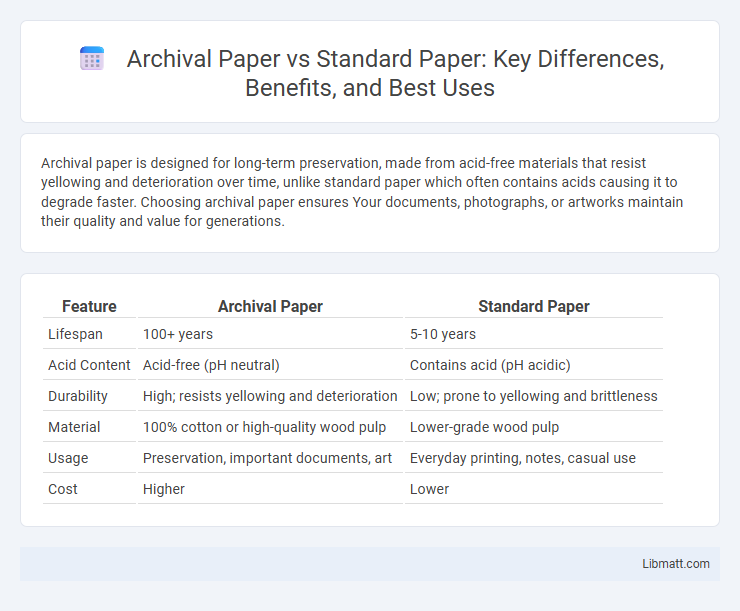Archival paper is designed for long-term preservation, made from acid-free materials that resist yellowing and deterioration over time, unlike standard paper which often contains acids causing it to degrade faster. Choosing archival paper ensures Your documents, photographs, or artworks maintain their quality and value for generations.
Table of Comparison
| Feature | Archival Paper | Standard Paper |
|---|---|---|
| Lifespan | 100+ years | 5-10 years |
| Acid Content | Acid-free (pH neutral) | Contains acid (pH acidic) |
| Durability | High; resists yellowing and deterioration | Low; prone to yellowing and brittleness |
| Material | 100% cotton or high-quality wood pulp | Lower-grade wood pulp |
| Usage | Preservation, important documents, art | Everyday printing, notes, casual use |
| Cost | Higher | Lower |
Introduction to Archival Paper vs Standard Paper
Archival paper is specifically designed to preserve important documents, photographs, and artwork for long-term storage, featuring acid-free and lignin-free properties that prevent yellowing and deterioration over time. Standard paper, commonly used for everyday printing and copying, typically contains acidic elements that cause it to degrade more quickly when exposed to light and air. Choosing archival paper ensures your valuable materials maintain their clarity and integrity for decades, unlike standard paper which is suitable for temporary or short-term use.
What is Archival Paper?
Archival paper is a high-quality, acid-free paper designed to preserve documents and artwork over long periods without yellowing or deteriorating. Unlike standard paper, which often contains lignin and acidic components causing rapid aging, archival paper uses cotton or other durable fibers to ensure longevity. Your important records or artworks benefit from archival paper's superior resistance to environmental factors and oxidation, maintaining integrity for decades or even centuries.
Characteristics of Standard Paper
Standard paper typically contains high levels of acids and lignin, which contribute to its rapid deterioration and yellowing over time. It is often made from wood pulp without extensive processing to remove these components, making it less durable for long-term preservation. The shorter lifespan and lower resistance to environmental factors make standard paper unsuitable for archival purposes.
Key Differences Between Archival and Standard Papers
Archival paper is specifically designed to resist deterioration over time, featuring acid-free composition and lignin-free materials that prevent yellowing and brittleness, whereas standard paper often contains acidic components that accelerate aging. Archival paper typically exhibits higher durability, enhanced pH neutrality, and superior preservation qualities, making it ideal for important documents, artwork, and historical records. Standard paper serves everyday use with lower production costs and reduced longevity, lacking the specialized chemical treatments found in archival-grade alternatives.
Durability and Longevity Comparison
Archival paper offers superior durability and longevity compared to standard paper due to its acid-free and lignin-free composition, which prevents yellowing and deterioration over time. Its high-resistance fibers ensure that important documents, photos, or artworks remain preserved for decades or even centuries without significant degradation. Choosing archival paper guarantees that Your valuable records withstand environmental factors and maintain integrity far longer than those printed on standard paper.
Uses and Applications of Archival Paper
Archival paper is specifically designed for long-term preservation of important documents, artworks, photographs, and historical records, ensuring resistance to deterioration, yellowing, and acid damage over decades or centuries. Standard paper is commonly used for everyday printing, note-taking, and short-term documents where longevity is not a priority. Your valuable records and archival projects require archival paper to maintain legibility and integrity through time, especially in libraries, museums, and legal settings.
Common Uses for Standard Paper
Standard paper is commonly used for everyday printing tasks such as documents, flyers, and school assignments due to its affordability and wide availability. It suits most office and home printers and is typically made from wood pulp, which lacks the longevity and durability of archival paper. Your choice to use standard paper is ideal for temporary records and routine communications where long-term preservation is not required.
Cost Analysis: Archival vs Standard Paper
Archival paper typically costs 50% to 100% more than standard paper due to its acid-free composition and higher durability standards. While initial expenses are higher, archival paper offers long-term savings by preventing document deterioration and reducing the need for frequent replacements. Businesses valuing longevity and document preservation often find the investment in archival paper more cost-effective over time compared to standard paper.
Environmental Impact of Both Paper Types
Archival paper is typically produced using acid-free, chlorine-free processes and often contains cotton fibers, resulting in a longer lifespan and reduced environmental degradation over time. Standard paper, commonly made from wood pulp with chemical treatments that include acids and bleaches, tends to degrade faster and contribute more to landfill waste and deforestation. The production of archival paper generally involves more sustainable forestry practices, minimizing carbon emissions and water pollution compared to conventional paper manufacturing.
Choosing the Right Paper for Your Needs
Archival paper offers superior acid-free, lignin-free composition that ensures long-term durability and prevents yellowing, making it ideal for important documents and artworks. Standard paper often contains acidic elements that cause rapid deterioration, suitable for everyday printing but not for preservation. Selecting archival paper is essential when longevity and quality are priorities, while standard paper serves well for general use and temporary purposes.
Archival paper vs standard paper Infographic

 libmatt.com
libmatt.com